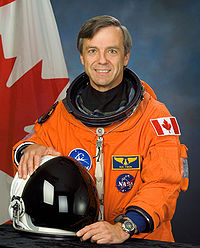Robert Brent Thirsk
| Robert Thirsk | |
|---|---|

|
|
| Country: | Canada |
| Organization: | CSA |
| selected on | December 5, 1983 ( 1st CSA group ), June 4, 1998 ( 17th NASA group ) |
| Calls: | 2 space flights |
| Start of the first space flight: |
June 20, 1996 |
| Landing of the last space flight: |
December 1, 2009 |
| Time in space: | 204d 18h 29min |
| retired on | August 13, 2012 |
| Space flights | |
|
|
Robert Brent "Bob" Thirsk OC (born August 17, 1953 in New Westminster , British Columbia Province , Canada ) is a retired Canadian astronaut . He was the first Canadian to fly a Soyuz and the first Canadian to go on a long-term mission.
Thirsk received a bachelor's degree in mechanical engineering from the University of Calgary in 1976 and a master's degree in mechanical engineering from the Massachusetts Institute of Technology in 1978 . He received a PhD in Medicine from McGill University in 1982 and a Master of Business Administration from MIT Sloan School of Management in 1998 .
Astronaut activity
In December 1983, Thirsk was selected by the National Research Council of Canada to join the Canadian Astronaut Program. In February 1984 he began his astronaut training. He was a substitute for the payload specialist Marc Garneau , who flew into space on the STS-41-G space shuttle mission on October 5, 1984. He took part in numerous parabolic flights aboard a NASA Boeing KC-135 and was involved in various projects on space medicine, the International Space Station (ISS), mission planning and training with the Canadian Space Agency . He led an international research team that investigated the effect of weightlessness on the cardiovascular system. His team developed and tested an experimental anti-gravity suit designed to help astronauts withstand the effects of long space flights on the circulatory system .
From 1993 to 1994 he was chief astronaut for the Canadian Space Agency. In February 1994, he was in command of the CAPSULS mission, a simulated seven-day space mission involving numerous international observers and three other Canadian astronauts.
STS-78
On June 20, 1996, Thirsk flew as a payload specialist with the space shuttle Columbia ( STS-78 ) on the longest mission of a space shuttle to date (16d 21h 48min). The task was weightlessness experiments in the Life and Microgravity Spacelab (LMS). These were needed as a basis for future experiments on the International Space Station (ISS). On this mission, Thirsk wrote two articles for the Calgary Sun newspaper that were published while Thirsk was still in space.
Astronaut training
In 1998, Thirsk went to the Johnson Space Center in Houston to participate in NASA's astronaut training program there. He learned how to use the systems of the space shuttle and the international space station, space exits , the use of robots and the Russian language . Thirsk worked as a liaison officer ( CAPCOM ) for the ISS.
In October 2004, Thirsk took part in an eleven-day mission to NASA's NEEMO underwater laboratory in Key Largo .
In 2004 Thirsk completed training at the Yuri Gagarin cosmonaut training center in Svyozdny Gorodok to become a flight engineer for the Soyuz spacecraft . For the Soyuz TMA-6 ISS mission in April 2005, he was the replacement flight engineer for the ESA astronaut Roberto Vittori .
At the end of 2007, Thirsk took part in a EUROCOM training (EUROCOM = European CAPCOM) in the German Columbus control center of ESA.
ISS expedition 20/21
Thirsk was assigned to ISS Expedition 20 as a flight engineer for the International Space Station. He took off for the ISS on May 27, 2009 with Soyuz TMA-15 , making him the first Canadian to fly in a Soyuz spacecraft. His return was originally planned for September 2009 with the space shuttle mission STS-129 . Due to delays in the shuttle flight plan, the flight of STS-129 was finally postponed to November 2009. Thirsk's return flight was moved to the same Soyuz spaceship, with, so that his return would not have been delayed too much in the event of a further postponement of STS-129 which he started. This also made him a member of Expedition 21 on the ISS. He finally landed in Kazakhstan on December 1, 2009 with Soyuz TMA-15. He spent a total of 185 days on board the ISS.
With 204 days in space, Thirsk is the most experienced Canadian astronaut.
Summary
| No. | mission | function | Flight period | Flight duration |
|---|---|---|---|---|
| 1 | STS-78 | Payload specialist | June 20 - 07.07.1996 | 16d 21h 48m |
| 2 | Soyuz TMA-15 | Flight engineer | 05/27 - 01.12.2009 | 187d 20h 42m |
Further career
Thirsk left the CSA on August 13, 2012 and has since been Vice President of Public, Government and Institute Affairs at the Canadian Institutes of Health Research .
Private
Robert Thirsk is married and has three children.
See also
Web links
- Short biography of Robert Brent Thirsk at spacefacts.de
- Biography of Robert Brent Thirsk in the Encyclopedia Astronautica (English)
- Canadian Space Agency: Biography (English)
swell
- ↑ Katherine Trinidad, Nicole Cloutier-Lemasters: NASA Assigns Space Station Crews, Updates Expedition Numbering. NASA, November 21, 2008, accessed November 21, 2008 .
- ^ Nicole Cloutier-Lemasters, Michael Curie: NASA Announces Change for Return of Station Crew Members. NASA, March 3, 2009, accessed May 22, 2009 .
- ↑ Biography of Dr. Robert (Bob) Brent Thirsk. In: Canadian Space Agency. July 19, 2012, accessed August 3, 2012 .
| personal data | |
|---|---|
| SURNAME | Thirsk, Robert Brent |
| ALTERNATIVE NAMES | Thirsk, Bob (nickname) |
| BRIEF DESCRIPTION | Canadian astronaut |
| DATE OF BIRTH | 17th August 1953 |
| PLACE OF BIRTH | New Westminster , British Columbia, Canada |